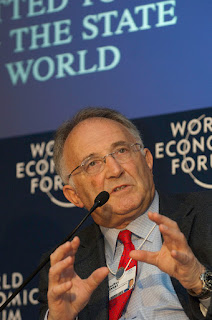Guest blog: Impact-Travel: A Sustainability Template
Geoffrey Lipman: SUNx Co-founder /President of ICTP
It feels good to be back in Manilla for more fun in the Philippines. Not the usual description of a UN Statistics Conference.
Even worse, I want to make two what I suspect are contrarian points about the proposed declaration. And then offer a suggestion to strengthen it.
First. The past is prologue. As a sector, we are not going far enough fast enough. This declaration needs to be half as wordy: twice as much implementation: four times as fast. And some real multi-stakeholder checks on delivery
Why? Because the scale and speed of change and connectivity is accelerating and if we don’t move at the same pace the decisions will be made outside our sector. By environmental and finance institutions; by business coalitions: by local authorities: by States and regions and by very smart cities.
This is not business as usual. Climate change is existential. Repeat existential.
Second, we need to expand our vision of measurement of sustainable tourism. We are moving into a new age of SDG and Paris targets
Linked Environment and Tourism Satellite Accounts are a good step. But it’s a first step that should have been taken more than a decade ago – when some of us were actively calling for it.
I repeat we need to cover the green part of the equation much faster.
And it needs to have more emphasis on measuring climate resilience. If we don’t fix Climate Change: it will fix us.
How to do this will take as much of a paradigm shift in the use of statistics as in security, product or technology adoption.
We have to cut through the admirable but dangerous, shifting clutter of 17 SDG’s, 169 Targets and 304 indicators with hundreds of national and supra-national groups with their version of the transformation roadmap for the future of everything.
And more so as the real consequences of tourism - good and bad - are ultimately felt at the local level. The money, the jobs, the infrastructure as well as the strain on resources and cultural integrity.
The global figures are great for policy declarations and lobbying and rich companies and consultancies. Implementation is almost always local and SME focused.
We have to act from the bottom up simultaneously with the top down.
We need deadlines for change and we need to engage all key stakeholders in the process by 2020..
Clearly we need to move in the directions set out in the resolution – recognizing, observing, linking, intensifying and expanding collaboratively.
What I believe is missing is a template for a multiyear refocused directional shift that could be useful to countries, communities, companies and consumers Points that anyone, anywhere can easily check seeking sustainability in Tourism and Travel activities.
Our idea at SUNx for such a template is called Impact-Travel. It has three such points of focus.
Simple questions that give a clear sense of direction for providers and consumers alike. As to where we have to go NOW, to be where we have to be in 2050
As Dr Johnson said “Nothing so concentrates the mind, as the prospect of being hanged in the morning.” And make no mistake existential means being hanged in the morning.
It feels good to be back in Manilla for more fun in the Philippines. Not the usual description of a UN Statistics Conference.
Even worse, I want to make two what I suspect are contrarian points about the proposed declaration. And then offer a suggestion to strengthen it.
First. The past is prologue. As a sector, we are not going far enough fast enough. This declaration needs to be half as wordy: twice as much implementation: four times as fast. And some real multi-stakeholder checks on delivery
Why? Because the scale and speed of change and connectivity is accelerating and if we don’t move at the same pace the decisions will be made outside our sector. By environmental and finance institutions; by business coalitions: by local authorities: by States and regions and by very smart cities.
This is not business as usual. Climate change is existential. Repeat existential.
Second, we need to expand our vision of measurement of sustainable tourism. We are moving into a new age of SDG and Paris targets
Linked Environment and Tourism Satellite Accounts are a good step. But it’s a first step that should have been taken more than a decade ago – when some of us were actively calling for it.
I repeat we need to cover the green part of the equation much faster.
And it needs to have more emphasis on measuring climate resilience. If we don’t fix Climate Change: it will fix us.
How to do this will take as much of a paradigm shift in the use of statistics as in security, product or technology adoption.
We have to cut through the admirable but dangerous, shifting clutter of 17 SDG’s, 169 Targets and 304 indicators with hundreds of national and supra-national groups with their version of the transformation roadmap for the future of everything.
And more so as the real consequences of tourism - good and bad - are ultimately felt at the local level. The money, the jobs, the infrastructure as well as the strain on resources and cultural integrity.
The global figures are great for policy declarations and lobbying and rich companies and consultancies. Implementation is almost always local and SME focused.
We have to act from the bottom up simultaneously with the top down.
We need deadlines for change and we need to engage all key stakeholders in the process by 2020..
Clearly we need to move in the directions set out in the resolution – recognizing, observing, linking, intensifying and expanding collaboratively.
What I believe is missing is a template for a multiyear refocused directional shift that could be useful to countries, communities, companies and consumers Points that anyone, anywhere can easily check seeking sustainability in Tourism and Travel activities.
Our idea at SUNx for such a template is called Impact-Travel. It has three such points of focus.
- Are the Impacts measured and managed coherently: the good and the bad ones?
- Does it have Green Growth at the core: low carbon, Inclusionary, hyper-connected, bio-diversity sensitive & resource efficient?
- Is it Future focused – reflecting Paris 2050 targets, the SDGs, and the World Economic Forum’s Fourth Industrial Revolution – the best tracker of new directions we have found?
Simple questions that give a clear sense of direction for providers and consumers alike. As to where we have to go NOW, to be where we have to be in 2050
As Dr Johnson said “Nothing so concentrates the mind, as the prospect of being hanged in the morning.” And make no mistake existential means being hanged in the morning.






Comments
Post a Comment